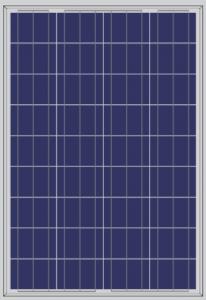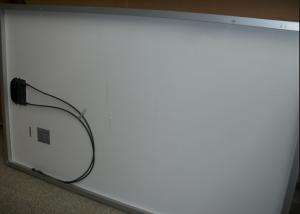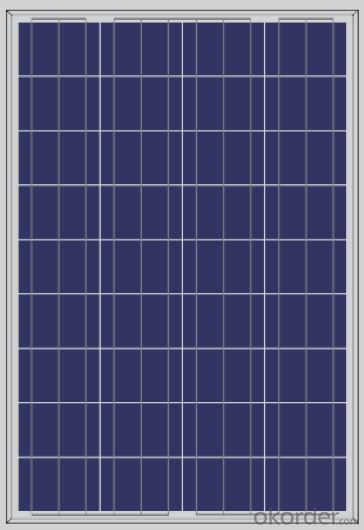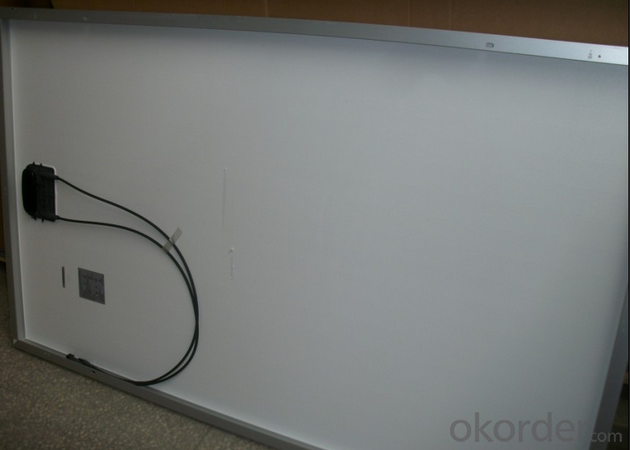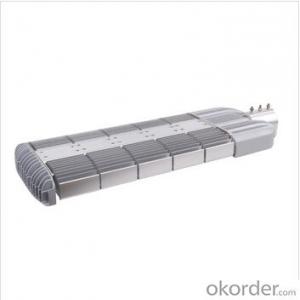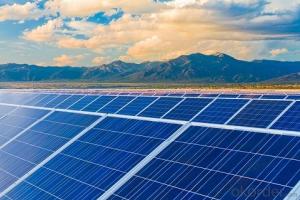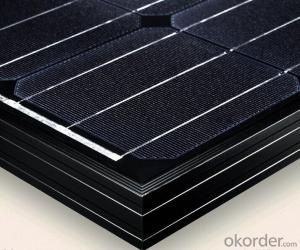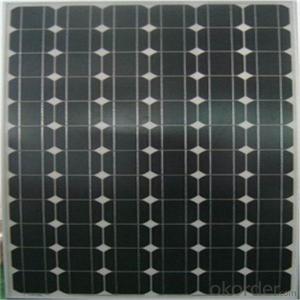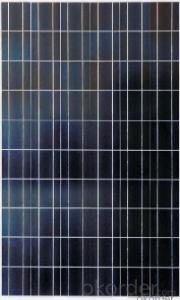Largo Solar Panels - Poly 110W Solar Panels from China Competitive Price
- Loading Port:
- Shanghai
- Payment Terms:
- TT or LC
- Min Order Qty:
- 1 watt
- Supply Capability:
- 1000000000 watt/month
OKorder Service Pledge
OKorder Financial Service
You Might Also Like
CNBM Solar is a world-leading and Vertical integrated manufacturer of high-performance with Silicon, Wafer, Cells, Modules, which convert sunlight into electricity for residential, commercial, and utility-scale power generation.
The capacity of CNBMSolar is reach to 1GW, and make sure each year our shipment capacity is more than 700-800MWs, at the same time, we have set up the largest solar power station with our partner in Ukraine.
CNBM is a Quality + Service oriented company with“Excellence at Each Step” approach, composed of the finest components from TUV and IEC-certified partners around the world, CNBM modules consistently undergo a variety of trials at the company’s Test & Development Centre, ensuring peak performance capabilities.
The company is committed to develop and provide the world with clean and renewable energy to ease the energy shortages as well as human kind’s impact on the environment.


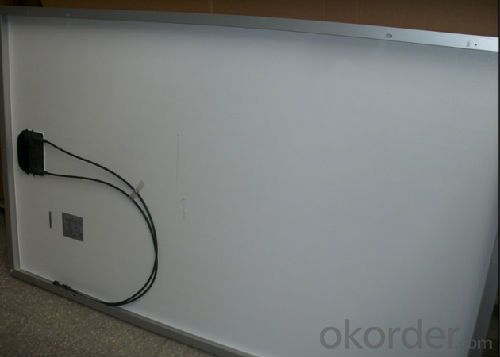
FAQ:
1.Can you provide the peripheral products of the solar panels, such as the battery, controller, and inverter? If so, can you tell me how do they match each other?
Yes, we can, we have two companies for solar region, one is CNBM International, the other is CNBM engineering Co.
We can provide you not only the solar module but also the off grid solar system, we can also provide you service with on grid plant.
2.What is your warranty system?
Our product performance guarantees for 25 years
• 12 years guarantee for workmanship
• Timeliness of delivery
• Quality Products certified (TÜV, UL, CE, ISO)
- Q: Can solar panels be installed on a barn or shed?
- Yes, solar panels can be installed on a barn or shed. In fact, barns and sheds often have large roof spaces that are ideal for solar panel installation. This allows the building to generate its own clean and renewable energy, reducing electricity costs and environmental impact.
- Q: if so, would it be possible to make (or remake) an organism that could subsist off of sunlight and external heat like plants?
- Plants and algaes and cyanobacteria already exist. What exactly do you want?
- Q: Can solar panels be used in cloudy regions?
- Yes, solar panels can still be used in cloudy regions. While solar panels do work best under direct sunlight, they can still generate electricity from diffused or scattered sunlight present in cloudy conditions. However, the overall energy output may be lower compared to sunny regions.
- Q: What specification of solar panel would I need to power a laptop every day? I would need to use it for about 0 hours or so every day. I don't know anything about solar panels, but I am seriously thinking of getting one now and don't know who to ask.
- You will need, A battery to store the electricity from the solar panel. The amount of electricity from the panel varies up and down as things such as clouds, position of the sun, etc. reduce the amount of solar rays hitting the panel. The battery stores it all, the ups and downs, and sends it back out at a steady voltage so you can operate your p.c. / appliance. A minimum of 45 watts solar panel. 60 watts would be preferable. 45 watts will charge a battery in one day under ideal conditions. You turn the panel as the sun moves across the sky, no clouds. 60 watts will charge a battery in one day with out moving and regardless of clouds. A controler to prevent the electricity from flowing backwards from the battery to the solar panel when the sun goes behind a cloud or sets at night and the charge drops below the voltage of the battery. A good controller will tell you the charge condition of your battery so you know when it is too low to operate your p.c. safely. And finally an inverter with True Sine Wave capability to change the electricity from the battery into usuable power for your PC and other electronics. Not all inverters produce true sine wave electricity. The electricity has static in it and will make your pc screen jump around and not function as it should. New digital T.V.'s also require true sine wave electricity to operate. Go the extra cost and get the inverter with true sine wave and be happy with the way your p.c. functions. Figure out how many Watts your p.c. or appliance will draw. and match the Inverter to the need. Do not go too big, as they cost more and consume more of your stored electricity to operate. Save as much electricity as you can. You will be able to operate your p.c. appliance longer. When not using your p.c., you can operate your T.V. or other low watt appliance.
- Q: Can solar panels be used for powering a water treatment plant?
- Yes, solar panels can be used to power a water treatment plant. Solar energy can be harnessed and converted into electricity to provide a sustainable and renewable power source for operating the various equipment and processes involved in water treatment. By utilizing solar panels, water treatment plants can reduce their dependence on traditional energy sources and contribute to a more environmentally friendly and cost-effective operation.
- Q: I need to write a pressuasive essay on why we should use solar panels more than we do. and convince people that their good and stuff.. if u guys could give me some good key reasons why..that would be great.
- Right now, the U.S. government and some state governments (like California) are offering subsidies on solar panels for businesses and houses. With these subsidies, anyone infesting in solar power today will have their investment returned in less than 0 years. This means that with these subsidies, solar panels are basically paying for themselves; they're free. In addition, excess power generated on solar panels can be added to the local power grid and, if you're lucky and can set it up with your local power distributor, the power company will pay you for the power you generate. This are just financial reasons. Their is also the reduction of power generated by fossil fuels when using solar power which mitigates climate change.
- Q: I bought a pack of OEM mini solar panels that produce 4.2v and 22mA and I was just wondering how many LED's I could hook up to one mini solar panel? I currently have one green LED with a resistor on the one panel but was wondering how many I could possibly run off of one panel?
- Typically LED's run off low voltage and 20mA or so of power (it depends what kind of led you have). That being said if one of your solar panels only provides 22mA of power then your circuit would have to be a series circuit for you to connect more than one. In a series circuit the current supplied of 22mA will go through each LED whereas a parallel circuit the current would be divided for each subsequential led. So in your case i can see you getting away with 3 or so led's before the voltage drop across each led will cause the voltage to be insufficient enough to drive anymore. Keep in mind the LED's will turn on but the first one will be bright then next one not as bright and so on. If you opted out and bought a solar panel with 200mA and 4V you could wire the led's in parallel and get 0 led's to turn on with the same brightness or intensity. Hoped that helped!
- Q: Hey was looking at a 5 watt 2 volt solar panel and was wondering if it'd be enough to power a regular light bulb. Also need to power a 5volt 6.5 amp pump for at most a minute at a time. So basically if I had this panel would I be able to plug a lamp into it and have it light for 5+ hours at a time with the possibility of running the pump? If not what size panel would I need?
- The specifications you give say the solar panel produces 5 watts at 2 volts (DC) so that isn't enough voltage to power an ordinary (20-volt) light bulb. You could get 0 of these panels and connect them in series so they put out a total of 20 volts and the total power available would be 50 watts. The panels would light the bulb that way, provided the bulb isn't over 50 watts and you can afford the panels. A panel does provide enough power for a 2-volt car light bulb less than 5 watts. However, the maximum current you can get from these panels is .25 amperes (5 watts divided by 2 volts = .25 A.) This isn't enough power to run your pump which takes 6.5 amperes - at 20 volts, that would be 780 watts. Another thing to check is the pump motor; many electric motors are designed to run on AC only and will be damaged if you try to run DC through them. Remember solar panels produce DC so the raw output from a panel will not work on an AC motor.
- Q: I'm trying to charge rechargeable AA batteries with a solar panel. What gauge wire should I use to connect the panel to the batteries? I know I'm not going to have a lot of current going through so the wire size doesn't really matter. Can the wire be too thick thoShould I ugh? Should I use a diode to keep the batteries from overpowering the circuit? If so, what size diode? My panel is 4.8V 50mA. Can I just hook the panel straight into the batteries or do I need something else?
- In order: .? Just about any wire will do.? You can handle 50 mA over just about anything, even 28 gauge telephone wire.? Your biggest problems are probably going to be mechanical stress (you want stranded wire instead of solid, to avoid breakage) and dealing with the size of larger wires. 8 gauge speaker wire may be a good optimum. 2.? You need a diode.? If you're charging NiMH or NiCd cells you're going to have about .25 volts/cell; you can charge up to 3 of them in series with a 4.8 volt panel.? The solar panel is a bunch of diodes itself, but they're leaky in the reverse direction; the diode prevents the batteries from discharging themselves back through the panel.? You want a Schottky-barrier diode, because the forward voltage drop is about 0.2 volts instead of 0.7 volts for a regular silicon rectifier.? This gives you maximum current output from your panel.
- Q: How could I find out what the amp output of a solar panel? Specifically, I want to know how many milliamps can the solar panel on a Casio fx-260 put out?
- You need full sunshine from the sun, or a lamp that will give a light spectrum similar to the sun, a volt meter, Milli-amp meter, and a variable resistor of 0 to 000 ohms. The voltmeter test leads go across the solar cell leads. The amp meter leads will be in series with the solar cell. Let's say, positive lead of the solar cell to the the positive lead of the amp meter, the negative lead of the amp meter to one terminal of the variable resistor, and the wiper terminal of the variable resistor to the negative lead of the solar cell. Slowly decrease the value of the resistor until the voltage from the solar cell just begins to drop. Take note of the amp meter reading. This is about the high end range of the solar cell. You might want to begin with a micro-amp meter for the current meter.
Send your message to us
Largo Solar Panels - Poly 110W Solar Panels from China Competitive Price
- Loading Port:
- Shanghai
- Payment Terms:
- TT or LC
- Min Order Qty:
- 1 watt
- Supply Capability:
- 1000000000 watt/month
OKorder Service Pledge
OKorder Financial Service
Similar products
Hot products
Hot Searches
Related keywords
